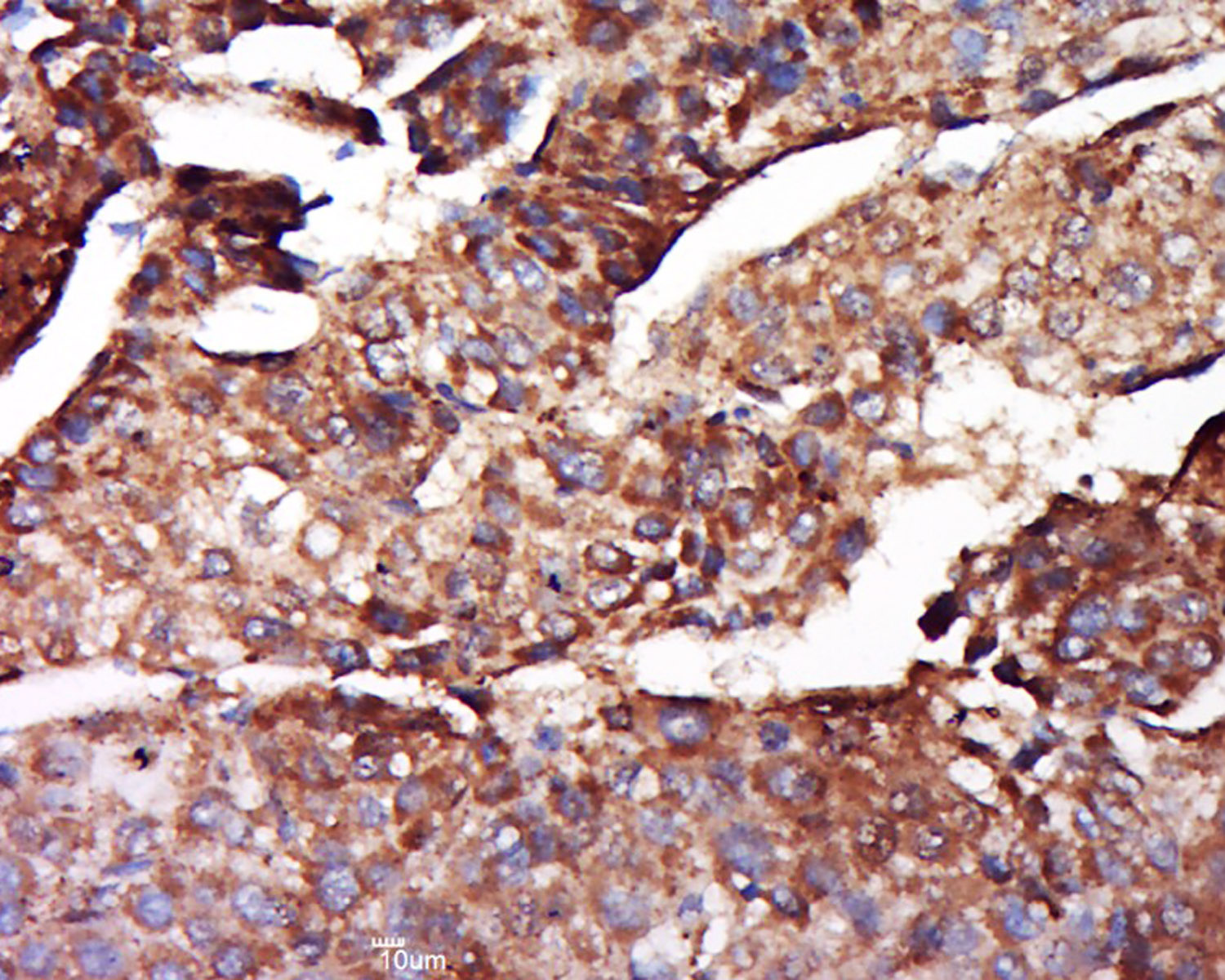
Rabbit Anti-Ferritin Heavy Chain antibody
Apoferritin; Cell proliferation inducing gene 15 protein; F HC; Ferritin H subunit; Ferritin heavy chain; Ferritin heavy polypeptide 1; FHC; FRIH; FTH 1; FTH; FTH1; FTH1 protein; FTHL 6; FTHL6; Iron overload autosomal dominant; MGC104426; OK/SW-cl.84; PIG
View History [Clear]
Details
Product Name Ferritin Heavy Chain Chinese Name 铁蛋白重链抗体 Alias Apoferritin; Cell proliferation inducing gene 15 protein; F HC; Ferritin H subunit; Ferritin heavy chain; Ferritin heavy polypeptide 1; FHC; FRIH; FTH 1; FTH; FTH1; FTH1 protein; FTHL 6; FTHL6; Iron overload autosomal dominant; MGC104426; OK/SW-cl.84; PIG 15; PIG15; Placenta immunoregulatory factor; PLIF; Proliferation inducing gene 15 protein; Proliferation inducing protein 15; FRIH_HUMAN. literatures Research Area Tumour Cardiovascular Cell biology Neurobiology Immunogen Species Rabbit Clonality Polyclonal React Species Human, (predicted: Mouse, Rat, Chicken, Dog, Cow, Horse, Rabbit, Sheep, ) Applications ELISA=1:5000-10000 IHC-P=1:100-500 IHC-F=1:100-500 ICC=1:100-500 IF=1:100-500 (Paraffin sections need antigen repair)
not yet tested in other applications.
optimal dilutions/concentrations should be determined by the end user.Theoretical molecular weight 21kDa Cellular localization The nucleus cytoplasmic Extracellular matrix Form Liquid Concentration 1mg/ml immunogen KLH conjugated synthetic peptide derived from human Ferritin Heavy Chain: 31-130/183 Lsotype IgG Purification affinity purified by Protein A Buffer Solution 0.01M TBS(pH7.4) with 1% BSA, 0.03% Proclin300 and 50% Glycerol. Storage Shipped at 4℃. Store at -20 °C for one year. Avoid repeated freeze/thaw cycles. Attention This product as supplied is intended for research use only, not for use in human, therapeutic or diagnostic applications. PubMed PubMed Product Detail Mammalian ferritins consist of 24 subunits made up of two types of poly-peptide chains, ferritin heavy chain and ferritin light chain, which each have unique functions. Ferritin heavy chains catalyze the first step in iron storage, the oxidation of FeII, whereas ferritin light chains promote the nucleation of ferrihydrite, enabling storage of FeIII. The most prominent role of mamma-lian ferritins is to provide iron-buffering capacity to cells. In addition to iron buffering, heavy chain ferritin is also involved in the regulation of thymidine biosynthesis via increased expression of cytoplasmic serine hydroxymethyltransferase, which is a limiting factor in thymidylate synthesis in MCF-7 cells. Light chain ferritin is involved in cataracts by at least two mechanisms: hereditary hyperferritinemia cataract syndrome, in which light chain ferritin is overexpressed; and oxidative stress, an important factor in the development of aging-related cataracts.
Function:
Ferritin is a ubiquitous and highly conserved protein which plays a major role in iron homeostasis by sequestering and storing iron in a non-toxic and soluble form. It forms a holoenzyme of ~450 kDa, consisting of 24 subunits of two types, H (heavy; 21 kDa) and L (light; 19 kDa), and is capable of storing up to 4,500 atoms of ferric iron. Depending on the tissue type and physiological status of the cell, the ratio of H to L subunits in ferritin can vary widely. Ferritin is found in the liver, spleen, kidney and heart, with smaller amounts being found in blood. Serum ferritin levels serve as an indicator of the amount of iron stored in the body. Serum ferritin is the most sensitive test for anaemia, and is also used as a marker for restless leg syndrome, hemochromatosis and porphyria. As ferritin is an acute-phase reactant, it is often elevated during infection. Defects in ferritin proteins are associated with several neurodegenerative diseases.
Subunit:
Oligomer of 24 subunits. There are two types of subunits: L (light) chain and H (heavy) chain. The major chain can be light or heavy, depending on the species and tissue type. The functional molecule forms a roughly spherical shell with a diameter of 12 nm and contains a central cavity into which the insoluble mineral iron core is deposited.
Subcellular Location:
Cytoplasmic.
Tissue Specificity:
In human liver the heavy chain is the major chain.
Similarity:
Belongs to the ferritin family.
Contains 1 ferritin-like diiron domain.
SWISS:
P02794
Gene ID:
2495
Database links:
Entrez Gene: 2495 Human
Entrez Gene: 14319 Mouse
Omim: 134770 Human
SwissProt: P02794 Human
SwissProt: P09528 Mouse
Unigene: 524910 Human
Unigene: 645560 Human
Unigene: 1776 Mouse
Product Picture
Antigen retrieval: citrate buffer ( 0.01M, pH 6.0 ), Boiling bathing for 15min; Block endogenous peroxidase by 3% Hydrogen peroxide for 30min; Blocking buffer (normal goat serum,C-0005) at 37℃ for 20 min;
Incubation: Anti-FHC Polyclonal Antibody, Unconjugated(SL8679R) 1:500, overnight at 4°C, followed by conjugation to the secondary antibody(SP-0023) and DAB(C-0010) staining
References (0)
No References
Bought notes(bought amounts latest0)
No one bought this product
User Comment(Total0User Comment Num)
- No comment



 +86 571 56623320
+86 571 56623320
 +86 18668110335
+86 18668110335

